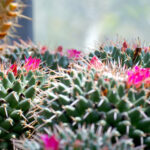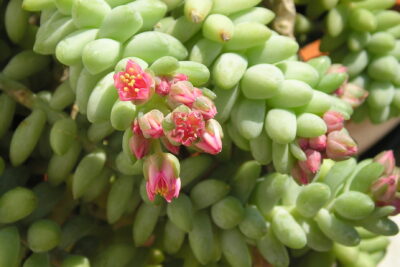
10 Unique Indoor Succulents That Resemble Hair for a Whimsical Touch

Indoor plants have become increasingly popular in recent years, as they not only add a touch of greenery to our living spaces but also provide numerous health benefits. One type of indoor plant that has gained significant attention is the succulent. Succulents are known for their ability to store water in their leaves, making them low-maintenance and perfect for those with busy lifestyles. While there are many different types of succulents available, some varieties stand out for their unique appearance, specifically those that resemble hair.
We will explore ten unique indoor succulents that resemble hair, adding a whimsical touch to any home or office. We will delve into the characteristics of each plant, including their care requirements, growth patterns, and unique features. Whether you are a seasoned plant lover or just starting your indoor gardening journey, this article will provide you with inspiration and information on how to incorporate these beautiful and unusual succulents into your space.
- Choose the String of Pearls succulent for cascading "hair" effect
- Go for the Bunny Ear cactus for a cute and fluffy appearance
- Opt for the Ponytail Palm for long, flowing "hair"
- Consider the Echeveria pulvinata with its fuzzy, red "locks"
- Select the Crassula muscosa for a mossy and green "hair" look
- Try the Sedum morganianum for its trailing and braided "hair" appearance
- Go for the Crassula ovata 'Gollum' with its tubular and finger-like "hair"
- Consider the Senecio radicans for its vine-like "hair" that cascades down
- Choose the Rhipsalis cereuscula for a curly and wild "hair" style
- Opt for the Kalanchoe tomentosa for its soft and fuzzy "hair" texture
- The String of Pearls succulent is a great choice for a cascading "hair" effect
- If you want a cute and fluffy appearance, go for the Bunny Ear cactus
- The Ponytail Palm will provide long, flowing "hair"
- The Echeveria pulvinata has fuzzy, red "locks"
- For a mossy and green "hair" look, select the Crassula muscosa
- The Sedum morganianum has trailing and braided "hair" appearance
- The Crassula ovata 'Gollum' has tubular and finger-like "hair"
- The Senecio radicans has vine-like "hair" that cascades down
- If you prefer a curly and wild "hair" style, choose the Rhipsalis cereuscula
- The Kalanchoe tomentosa has soft and fuzzy "hair" texture
- Frequently Asked Questions
Choose the String of Pearls succulent for cascading "hair" effect
If you're looking for a succulent that adds a whimsical touch to your indoor space, look no further than the String of Pearls succulent. This unique plant features long, trailing stems that resemble strands of hair, creating a cascading effect that is sure to catch everyone's attention.
The String of Pearls succulent, also known as Senecio rowleyanus, is native to South Africa and is a popular choice for indoor gardens and hanging planters. Its unique appearance makes it a standout among other succulents, and its low maintenance nature makes it perfect for those who are new to gardening or have a busy lifestyle.
One of the most striking features of the String of Pearls succulent is its bead-like leaves, which grow along the trailing stems. These leaves are round and green, resembling small pearls, hence the name. The plant's stems can grow up to two feet long, creating a beautiful draping effect when placed in a hanging planter or on a high shelf.
To care for your String of Pearls succulent, make sure to place it in a well-lit area, preferably near a window where it can receive bright, indirect sunlight. This plant thrives in well-draining soil, so it's important to use a succulent potting mix or add perlite to regular potting soil to improve drainage.
Watering the String of Pearls succulent can be a bit tricky, as overwatering can lead to root rot. It's best to let the soil dry out completely between waterings and then water thoroughly, allowing the excess water to drain out of the pot. During the winter months, when the plant is in its dormancy period, reduce watering to once every two to three weeks.
 Top 10 Tall Succulent Plants: Perfect for Indoor or Outdoor Use
Top 10 Tall Succulent Plants: Perfect for Indoor or Outdoor UseWhether you choose to display your String of Pearls succulent in a hanging planter, on a shelf, or as part of a succulent arrangement, its unique "hair" effect is sure to add a whimsical touch to your indoor space. So why not bring a touch of nature and whimsy into your home with this charming succulent?
Go for the Bunny Ear cactus for a cute and fluffy appearance
The Bunny Ear cactus is a unique indoor succulent that adds a whimsical touch to any space. With its cute and fluffy appearance, it is sure to catch the attention of anyone who sees it. This succulent gets its name from its distinctive appearance, which resembles the ears of a bunny.
One of the reasons why the Bunny Ear cactus is a popular choice among succulent enthusiasts is its low maintenance requirements. This succulent thrives in bright, indirect light and requires minimal watering. Its thick, fleshy leaves store water, allowing it to survive in dry conditions.
When it comes to aesthetics, the Bunny Ear cactus is a showstopper. Its green, pad-like leaves are covered in fine white spines, giving it a soft and fluffy appearance. The pads grow in a stacked formation, creating a unique and eye-catching display.
The Bunny Ear cactus is not only visually appealing but also a great choice for those who want to propagate their succulents. It readily produces offsets, which are small plants that grow from the base of the main plant. These offsets can be easily separated and planted to create new Bunny Ear cactus plants.
Whether you're a succulent enthusiast or simply looking to add a touch of whimsy to your indoor space, the Bunny Ear cactus is an excellent choice. Its cute and fluffy appearance, low maintenance requirements, and ease of propagation make it a must-have for any succulent collection.
 Exploring Fred Ives: A Specialist in Succulent Cultivation
Exploring Fred Ives: A Specialist in Succulent CultivationOpt for the Ponytail Palm for long, flowing "hair"
If you're looking to add a touch of whimsy to your indoor garden, the Ponytail Palm is the perfect choice. With its long, flowing leaves that resemble a ponytail, this unique succulent is sure to be a conversation starter.
The Ponytail Palm, also known as Beaucarnea recurvata, is native to Mexico and is a member of the Agave family. Despite its name, it is not actually a palm tree but rather a succulent. Its long, slender leaves grow from a swollen base, giving it the appearance of a ponytail.
This indoor succulent is relatively easy to care for, making it a popular choice for both experienced gardeners and beginners alike. It prefers bright, indirect light and should be watered sparingly, allowing the soil to dry out between waterings. Overwatering can lead to root rot, so it's important to ensure proper drainage.
The Ponytail Palm can grow up to 10 feet tall in its natural habitat, but it is slow-growing indoors. With proper care, it can reach a height of around 4 feet. Its unique appearance and low-maintenance nature make it an excellent choice for adding a touch of whimsy to any indoor space.
Key Features:
- Resembles a ponytail with its long, flowing leaves
- Native to Mexico and a member of the Agave family
- Easy to care for, making it suitable for all levels of gardeners
- Prefers bright, indirect light and well-draining soil
- Slow-growing indoors, reaching a height of around 4 feet
Consider the Echeveria pulvinata with its fuzzy, red "locks"
The Echeveria pulvinata is a fascinating succulent that boasts a whimsical touch with its unique appearance resembling hair. This succulent variety is known for its fuzzy, red "locks" that give it an eye-catching and playful appeal.
The Echeveria pulvinata, also known as the Ruby Slippers or Plush Plant, is native to Mexico. It features rosettes of densely packed, spoon-shaped leaves that are covered in fine, velvety hairs. These hairs give the plant a soft and fuzzy texture, adding to its charm and making it a standout choice for any indoor garden.
 Top Succulents with White Hair: A Guide to the Best Varieties
Top Succulents with White Hair: A Guide to the Best VarietiesWhat sets the Echeveria pulvinata apart from other succulents is its vibrant red color. The leaves feature a stunning shade of red that intensifies when exposed to bright sunlight. This striking coloration adds a touch of drama and uniqueness to any space, making it a perfect choice for those looking to create a visually captivating indoor display.
When it comes to care, the Echeveria pulvinata is relatively easy to maintain. It requires bright, indirect light and should be placed near a sunny window or under grow lights. Like most succulents, this variety prefers well-draining soil and infrequent watering. Overwatering can lead to root rot, so it's important to allow the soil to dry out completely between waterings.
As for propagation, the Echeveria pulvinata can be propagated through leaf cuttings or offsets. Simply remove a healthy leaf or offset from the main plant and allow it to callus over before planting it in well-draining soil. With proper care and attention, you can easily grow a collection of these charming succulents.
Whether you're a seasoned succulent enthusiast or a beginner looking to add some whimsy to your indoor garden, the Echeveria pulvinata is a fantastic choice. Its fuzzy, red "locks" and vibrant color make it a unique and eye-catching addition to any space. So why not introduce a touch of whimsy with this delightful succulent?
Select the Crassula muscosa for a mossy and green "hair" look
Crassula muscosa, also known as the Watch Chain or Princess Pine, is a unique indoor succulent that resembles hair with its delicate, elongated green leaves. This fascinating plant is sure to add a whimsical touch to any space.
The Crassula muscosa is quite versatile and can be grown both indoors and outdoors. However, it thrives best in well-draining soil and bright, indirect sunlight. It is important to water this succulent sparingly, as overwatering can lead to root rot.
One of the most intriguing features of the Crassula muscosa is its ability to change color. When exposed to direct sunlight, the leaves can turn a beautiful reddish hue, adding even more visual interest to its "hair" appearance.
 Top 10 Succulents That Flourish in Partial Sunlight: A Guide
Top 10 Succulents That Flourish in Partial Sunlight: A GuideThis succulent is relatively low-maintenance and can withstand periods of neglect. It is perfect for busy individuals or those new to gardening. With its unique hair-like foliage, the Crassula muscosa will undoubtedly become a conversation starter and a focal point in any indoor garden or plant collection.
Try the Sedum morganianum for its trailing and braided "hair" appearance
The Sedum morganianum, also known as the Burro's Tail or Donkey's Tail, is a captivating indoor succulent that will add a whimsical touch to any space. Its unique trailing and braided "hair" appearance makes it stand out among other succulents.
This succulent features long, slender stems that are densely covered in small, plump leaves. The leaves grow in a cascading manner, resembling a lush and flowing mane. The Sedum morganianum's foliage is a lovely shade of blue-green, which adds a cool and soothing element to its overall aesthetic.
Not only is this succulent visually appealing, but it is also easy to care for. It thrives in bright indirect light and requires minimal watering. In fact, overwatering can be detrimental to its health, so it's important to let the soil dry out between waterings.
For those looking to incorporate some creativity into their home decor, the Sedum morganianum can be easily manipulated to create unique braided or twisted designs. This feature allows you to showcase your artistic side while also enjoying the beauty of this exceptional succulent.
Whether you place it in a hanging basket, on a shelf, or as a centerpiece, the Sedum morganianum is sure to be a conversation starter and a delightful addition to your indoor plant collection.
Go for the Crassula ovata 'Gollum' with its tubular and finger-like "hair"
 Exploring the Beauty of Sedum Sunset Succulent: A Comprehensive Guide
Exploring the Beauty of Sedum Sunset Succulent: A Comprehensive GuideCrassula ovata 'Gollum'
If you are looking to add a whimsical touch to your indoor garden, look no further than the Crassula ovata 'Gollum'. This unique succulent is known for its tubular and finger-like "hair" that resembles the iconic character from J.R.R. Tolkien's The Lord of the Rings. With its unusual appearance, it is sure to catch the attention of anyone who lays eyes on it.
Not only does the Crassula ovata 'Gollum' make a great conversation starter, but it is also a relatively easy plant to care for. It belongs to the Crassulaceae family and is native to South Africa. This succulent thrives in bright, indirect light and prefers well-draining soil. It is important not to overwater it, as succulents are known for their ability to store water in their leaves.
To keep your Crassula ovata 'Gollum' healthy, allow the soil to dry out completely between waterings. Remember, it is better to underwater than to overwater this plant. As for fertilizing, a diluted succulent fertilizer once a month during the growing season should be sufficient.
This succulent can be propagated easily through stem cuttings. Simply take a healthy stem cutting and allow it to callous over for a few days. Then, place it in well-draining soil and water sparingly until roots develop.
Whether you choose to display it on a windowsill, in a terrarium, or as part of a succulent arrangement, the Crassula ovata 'Gollum' is sure to add a touch of whimsy and charm to your indoor space. Its unique "hair" makes it a standout among other succulents, and its ease of care makes it a perfect choice for both beginners and experienced plant enthusiasts alike.
Consider the Senecio radicans for its vine-like "hair" that cascades down
If you're looking for a whimsical touch to add to your indoor garden, the Senecio radicans is the perfect choice. This unique succulent, also known as "String of Bananas," features long, trailing stems that resemble cascading hair. Its vibrant green color and delicate tendrils create a stunning visual effect, adding a touch of playfulness to any space.
The Senecio radicans is a low-maintenance plant, making it ideal for both beginner and experienced gardeners. It thrives in bright, indirect light and prefers well-draining soil. You can easily propagate this succulent by taking stem cuttings and placing them in a new pot with fresh soil.
 Black Beauty: A Guide to Succulents with Stunning Black Leaves
Black Beauty: A Guide to Succulents with Stunning Black LeavesOne of the fascinating aspects of the Senecio radicans is its ability to grow in a variety of containers. Whether you choose a hanging basket, a wall-mounted planter, or a decorative pot, this succulent will beautifully drape down, resembling flowing locks of hair.
To care for the Senecio radicans, ensure that you water it thoroughly but allow the soil to dry out between waterings. Overwatering can lead to root rot, so it's essential to strike the right balance. Additionally, this succulent appreciates a bit of humidity, so misting the leaves occasionally can be beneficial.
With its unique "hair" and cascading growth habit, the Senecio radicans is sure to be a conversation starter in any indoor garden. Its whimsical appearance adds a touch of magic and charm, making it an excellent choice for those looking to create a playful atmosphere.
Choose the Rhipsalis cereuscula for a curly and wild "hair" style
The Rhipsalis cereuscula is an ideal choice if you're looking to add a whimsical touch to your indoor space. This unique succulent species features thin, elongated stems that cascade down like curly locks of hair. Its vibrant green color and delicate texture make it a captivating addition to any room.
One of the great things about the Rhipsalis cereuscula is that it is relatively low-maintenance. It thrives in bright, indirect light and prefers well-draining soil. As a tropical plant, it appreciates regular misting to create a humid environment. However, be careful not to overwater it, as this can lead to root rot.
To care for this "hair-like" succulent, water it when the top inch of soil feels dry. During the winter months, you can reduce watering frequency as the plant enters a period of dormancy. Fertilize the Rhipsalis cereuscula every two to three months during the growing season to ensure it receives the necessary nutrients.
When it comes to styling, the Rhipsalis cereuscula looks stunning in hanging baskets or mounted on walls, allowing its cascading stems to create a mesmerizing curtain of hair-like foliage. It can also be combined with other succulents or trailing plants to add depth and visual interest to your indoor garden.
 Best Trailing Succulents: Explore Our Top Picks for Cascading Beauty
Best Trailing Succulents: Explore Our Top Picks for Cascading BeautyIf you're looking to turn heads and create a whimsical atmosphere in your home, the Rhipsalis cereuscula is the perfect choice. Its unique "hair" style will make it a conversation starter and a true standout among your collection of indoor plants.
Opt for the Kalanchoe tomentosa for its soft and fuzzy "hair" texture
If you're looking to add a whimsical touch to your indoor garden, look no further than the Kalanchoe tomentosa. This unique succulent is known for its soft and fuzzy "hair" texture, which resembles the appearance of a miniature plant with hair.
The Kalanchoe tomentosa, also known as the Panda Plant or Chocolate Soldier, is a small, compact succulent that is native to Madagascar. Its leaves are covered in tiny, velvety hairs, giving it a plush and distinctive look.
This succulent is a great choice for those who want to experiment with different textures in their indoor garden. The soft and fuzzy "hair" adds a playful and whimsical element to any space, making it a conversation starter and a favorite among succulent enthusiasts.
When it comes to care, the Kalanchoe tomentosa is relatively low-maintenance. It thrives in bright, indirect light and prefers well-draining soil. Like most succulents, it is drought-tolerant and should be watered sparingly, allowing the soil to dry out between waterings.
The Panda Plant is also known for its ability to purify the air, making it a great choice for indoor spaces. It helps remove toxins and improve the overall air quality, creating a healthier and more enjoyable environment.
 Succulents: Annuals or Perennials in Their Natural Habitat?
Succulents: Annuals or Perennials in Their Natural Habitat?With its unique "hair" texture, the Kalanchoe tomentosa is a must-have for any succulent enthusiast looking to add a touch of whimsy to their indoor garden. Its soft and fuzzy appearance, easy care requirements, and air-purifying properties make it a perfect choice for both beginners and experienced plant lovers.
The String of Pearls succulent is a great choice for a cascading "hair" effect
If you're looking to add a whimsical touch to your indoor plant collection, the String of Pearls succulent is the perfect choice. With its unique trailing vines that resemble cascading hair, this succulent is sure to be a conversation starter.
The String of Pearls succulent, also known as Senecio rowleyanus, features long, slender stems that are lined with small, round leaves. These leaves resemble tiny pearls, hence the name. As the plant grows, the stems can reach lengths of up to three feet, creating a stunning visual effect.
One of the reasons why the String of Pearls succulent is a popular choice among plant enthusiasts is its low maintenance nature. It is a drought-tolerant plant, meaning it can withstand periods of neglect when it comes to watering. This makes it a great choice for those who may not have a green thumb or are frequently on the go.
To ensure the String of Pearls succulent thrives, it is important to provide it with bright, indirect light. Placing it near a window or in a well-lit room will help it maintain its vibrant green color. Additionally, this succulent prefers well-draining soil, as it is susceptible to root rot if overwatered.
Another interesting aspect of the String of Pearls succulent is its ability to propagate easily. Simply cut off a few stems and place them in moist soil, and they will quickly develop roots and start growing into new plants. This makes it a great option for those who want to expand their collection or share this unique plant with friends and family.
 Low-Maintenance Plants with Succulent-Like Care and Appearance
Low-Maintenance Plants with Succulent-Like Care and AppearanceWhether you hang the String of Pearls succulent in a macrame planter, let it cascade down from a shelf, or use it as a centerpiece in a terrarium, its "hair-like" vines will add a whimsical touch to any indoor space. It's a truly unique succulent that is sure to capture the attention and admiration of anyone who sees it.
If you want a cute and fluffy appearance, go for the Bunny Ear cactus
The Bunny Ear cactus
If you want a cute and fluffy appearance, look no further than the Bunny Ear cactus. With its unique growth pattern and soft, hair-like spines, this succulent will bring a whimsical touch to any indoor space.
The Bunny Ear cactus, also known as Opuntia microdasys, is native to Mexico. It gets its name from its distinctive pads that resemble bunny ears. These pads are covered in small, hair-like spines called glochids, which give the plant its fluffy appearance.
This succulent is a low-maintenance plant that can thrive both indoors and outdoors. It prefers bright, indirect light, so placing it near a sunny window is ideal. However, be cautious of direct sunlight, as it can scorch the plant's delicate spines.
When it comes to watering, the Bunny Ear cactus is relatively drought-tolerant. It's important to allow the soil to dry out completely between waterings to prevent root rot. During the winter months, reduce watering frequency even further to mimic its natural dormant period.
The Bunny Ear cactus can be propagated through stem cuttings. Simply let the cuttings dry out for a few days before planting them in well-draining soil. With proper care, you can easily expand your collection of these adorable succulents.
 Discover Fred Ives' Top Recommended Succulent Varieties for Your Home
Discover Fred Ives' Top Recommended Succulent Varieties for Your HomeWhether you place it on a windowsill, in a terrarium, or as part of a succulent arrangement, the Bunny Ear cactus will add a touch of whimsy to your indoor space. Its fluffy appearance and unique growth pattern make it a standout among other succulents.
The Ponytail Palm will provide long, flowing "hair"
The Ponytail Palm is a unique indoor succulent that resembles flowing hair, making it the perfect addition for a whimsical touch to your home decor. With its long, slender leaves cascading downwards, it creates a stunning visual effect that is sure to catch the attention of anyone who enters the room.
This succulent gets its name from its resemblance to a ponytail, with its leaves growing in a way that resembles the strands of hair flowing down. Its scientific name, Beaucarnea recurvata, further emphasizes its hair-like appearance, as "recurvata" means "curved" in Latin, referring to the way the leaves curve and hang down gracefully.
In addition to its unique aesthetic appeal, the Ponytail Palm is also a low-maintenance plant, making it ideal for those who may not have a green thumb. It is highly adaptable to different light conditions and can thrive in both bright indirect light and low light environments. This makes it a versatile choice for any room in your home, whether it's a well-lit living room or a cozy bedroom corner.
When it comes to watering, the Ponytail Palm prefers to be slightly underwatered rather than overwatered. It stores water in its bulbous base, allowing it to survive periods of drought. Therefore, it's important to let the soil dry out between waterings to prevent root rot. With proper care, this succulent can live for many years, bringing its whimsical charm to your indoor space.
The Echeveria pulvinata has fuzzy, red "locks"
Echeveria pulvinata is a unique indoor succulent that adds a whimsical touch with its fuzzy, red "locks". This succulent variety is known for its rosette-shaped leaves that are densely covered with fine, velvety hairs, giving it a distinct and eye-catching appearance.
The Echeveria pulvinata is native to Mexico and is commonly referred to as "Chenille Plant" or "Ruby Blush" due to its striking red coloration. The fuzzy texture of its leaves adds an interesting tactile element to any indoor garden or succulent collection.
This succulent thrives in bright light conditions and prefers well-draining soil to prevent root rot. It is a relatively low-maintenance plant, making it a popular choice for both experienced and novice succulent enthusiasts.
When it comes to care, the Echeveria pulvinata requires infrequent watering. It is essential to allow the soil to dry out between watering sessions to avoid overwatering, which can lead to root rot. This succulent is also drought-tolerant, making it a resilient choice for indoor gardening.
Additionally, the Echeveria pulvinata can produce vibrant orange or yellow flowers on long stems during the spring and summer months. These flowers add an extra touch of beauty to an already stunning plant.
If you're looking to add a touch of whimsy to your indoor garden, the Echeveria pulvinata is a perfect choice. Its fuzzy, red "locks" are sure to capture attention and create a unique visual appeal.
For a mossy and green "hair" look, select the Crassula muscosa
The Crassula muscosa, also known as the Watch Chain Plant, is a unique indoor succulent that resembles hair with its mossy and green appearance. This whimsical plant is sure to add a touch of charm to any space.
With its cascading tendrils, the Crassula muscosa creates a visually stunning effect, resembling flowing locks of hair. Its slender stems are covered in small, fleshy leaves that give it a dense and lush look.
This succulent is not only visually appealing but also easy to care for, making it an ideal choice for both experienced gardeners and beginners. It thrives in bright indirect light and requires minimal watering. It can even tolerate low-light conditions, making it a versatile option for any indoor setting.
The Crassula muscosa is native to South Africa and belongs to the Crassulaceae family. It can be grown in a variety of containers, such as hanging baskets or pots, allowing you to get creative with its placement.
Whether you want to add a touch of whimsy to your living room, office, or even your bathroom, the Crassula muscosa is an excellent choice. Its unique hair-like appearance is sure to spark conversations and bring a sense of playfulness to your indoor space.
So, if you're looking for a succulent that will add a whimsical touch to your home, look no further than the Crassula muscosa. Its mossy and green "hair" will make a statement and bring a touch of nature indoors.
The Sedum morganianum has trailing and braided "hair" appearance
If you're looking to add a whimsical touch to your indoor space, the Sedum morganianum is the perfect succulent for you. Also known as the "Burro's Tail" or "Donkey's Tail," this unique plant features long, trailing stems that resemble braided hair. Its thick, fleshy leaves are densely packed together, creating a cascading effect that adds a touch of charm to any room.
The Sedum morganianum is native to Mexico and requires minimal care, making it an excellent choice for both beginner and experienced plant enthusiasts. With its distinctive appearance, it is sure to be a conversation starter and a standout addition to your indoor garden.
To ensure its healthy growth, the Sedum morganianum thrives in bright indirect light but can also tolerate some direct sunlight. It is important to provide well-draining soil to prevent root rot, as this succulent is susceptible to overwatering. Watering should be done sparingly, allowing the soil to dry out between each watering session.
One of the fascinating features of the Sedum morganianum is its ability to propagate easily. Simply take a cutting from one of the stems, allow it to callous for a few days, and then plant it in well-draining soil. Before you know it, you'll have multiple "hair-like" succulents cascading from various pots in your home.
Whether you choose to display it in a hanging basket, let it drape from a shelf, or use it as a unique centerpiece, the Sedum morganianum is sure to bring a touch of whimsy and beauty to your indoor space.
The Crassula ovata 'Gollum' has tubular and finger-like "hair"
If you're looking to add a touch of whimsy to your indoor space, the Crassula ovata 'Gollum' is the perfect succulent for you. This unique plant features tubular and finger-like leaves that resemble hair, giving it a truly distinctive and playful appearance. With its green color and unusual shape, it's sure to be a conversation starter in any room.
The Senecio radicans has vine-like "hair" that cascades down
The Senecio radicans, also known as "String of Bananas," is a unique indoor succulent that resembles hair, adding a whimsical touch to any space. This succulent features long, trailing vines that cascade down, creating a stunning visual effect.
With its elongated, curved leaves, the Senecio radicans closely resembles a flowing mane of hair, making it an eye-catching addition to your indoor garden or hanging plant arrangement. Its foliage is a vibrant shade of green, adding a pop of color to any room.
This succulent is relatively low-maintenance and can thrive in a variety of indoor environments. It prefers bright, indirect light and should be watered sparingly, allowing the soil to dry out between waterings. Overwatering can lead to root rot, so it's important to be mindful of its watering needs.
The Senecio radicans is a versatile plant that can be grown in a hanging basket, allowing its "hair" to dangle gracefully. Alternatively, it can be trained to climb up a trellis or allowed to spill over the edges of a shelf or container.
Whether you're a succulent enthusiast or simply looking to add a touch of whimsy to your indoor space, the Senecio radicans is a fantastic choice. Its unique hair-like vines will surely capture the attention of anyone who lays eyes on it.
If you prefer a curly and wild "hair" style, choose the Rhipsalis cereuscula
The Rhipsalis cereuscula
If you are looking to add a whimsical touch to your indoor space, the Rhipsalis cereuscula is the perfect choice. This succulent resembles a head of curly hair, adding a unique and playful element to your home or office decor.
The Rhipsalis cereuscula, also known as the Coral Cactus or Mistletoe Cactus, is an epiphytic succulent that is native to the rainforests of Brazil. Its cascading stems are thin and elongated, with small, rounded leaves that grow in clusters. The stems can reach lengths of up to 3 feet, creating a stunning draping effect that resembles flowing locks of hair.
This succulent is relatively easy to care for, making it a great choice for both beginner and experienced plant enthusiasts. It thrives in bright, indirect light, making it ideal for indoor spaces with ample natural light. However, it can also tolerate lower light conditions, making it versatile for different areas of your home.
When it comes to watering, the Rhipsalis cereuscula prefers to dry out between waterings. Overwatering can lead to root rot, so it's important to allow the soil to dry out completely before watering again. During the growing season, typically spring and summer, you can water more frequently, but reduce watering during the dormant period in the fall and winter.
Like most succulents, the Rhipsalis cereuscula prefers well-draining soil to prevent waterlogged roots. You can use a cactus or succulent-specific potting mix or create your own by combining regular potting soil with perlite or sand to improve drainage.
As for temperature, this succulent thrives in average room temperatures between 60-75°F (15-24°C). Avoid exposing it to extreme temperature fluctuations and drafts, as it can negatively affect its growth.
To keep your Rhipsalis cereuscula looking its best, you can fertilize it once a month during the growing season with a diluted, balanced houseplant fertilizer. This will provide the necessary nutrients for healthy growth and vibrant foliage.
With its unique appearance and low maintenance requirements, the Rhipsalis cereuscula is a fantastic choice for adding a touch of whimsy to any indoor space. Whether you place it in a hanging basket or let it cascade down from a shelf, this succulent is sure to attract attention and bring a playful vibe to your home or office.
The Kalanchoe tomentosa has soft and fuzzy "hair" texture
The Kalanchoe tomentosa, also known as the Panda Plant or Chocolate Soldier, is a unique indoor succulent that adds a whimsical touch to any space. What sets this succulent apart is its soft and fuzzy "hair" texture, which resembles the coat of a panda or a chocolate soldier.
The leaves of the Kalanchoe tomentosa are thick and oval-shaped, covered in a dense layer of tiny, fine hairs. These hairs give the plant a velvety appearance and a delightful tactile experience when touched. The color of the leaves can vary from light green to a silvery-gray, with reddish-brown tips.
This succulent is relatively easy to care for, making it a popular choice for both beginner and seasoned plant enthusiasts. It prefers bright, indirect light and well-draining soil. Watering should be done sparingly, allowing the soil to dry out between waterings to prevent root rot.
The Kalanchoe tomentosa is not only visually appealing but also has air-purifying properties, making it a great addition to any indoor space. Its unique appearance and low maintenance needs make it a perfect choice for those looking to add a touch of whimsy to their home or office.
Frequently Asked Questions
1. How do I care for indoor succulents?
Indoor succulents require well-draining soil, bright indirect light, and infrequent watering to thrive.
2. Can indoor succulents survive in low light conditions?
While some succulents can tolerate low light, most prefer bright indirect light to maintain their vibrant colors and compact growth.
3. How often should I water indoor succulents?
Succulents are drought-tolerant plants, so it's best to water them sparingly. Wait until the soil is completely dry before watering, usually every 1-2 weeks.
4. Do indoor succulents need fertilizer?
Succulents generally do not require frequent fertilization. You can use a balanced, diluted liquid fertilizer during the growing season, but be cautious not to over-fertilize as it can harm the plants.
If you want to read more articles similar to 10 Unique Indoor Succulents That Resemble Hair for a Whimsical Touch, you can visit the Varieties and Colors category.






You Must Read